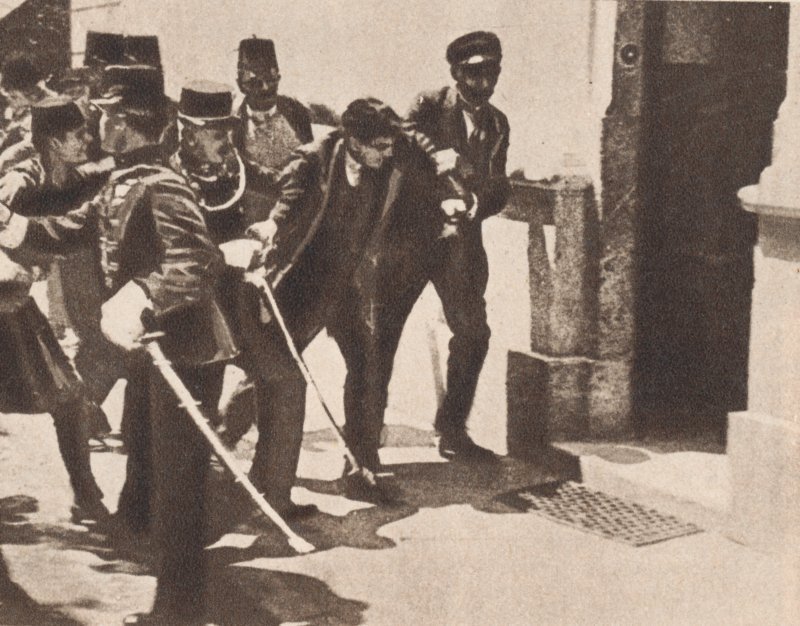Gavrilo Princip was 19 years old when he assassinated the Archduke of Austria and his wife, Sophie, Duchess of Hohenberg. Princip was born a Serb but grew up in Bosnia. There, he became a Bosnian nationalist through his membership with Mlada Bosna — Young Bosnia. The group’s purpose was to unify Bosnia. This was not an easy task.

The Monarchy the Mlada Bosna was up against was that of the Austrian Empire. For years Austria had been dismantling the Balkan region. The Monarchy was swallowing swaths of Serbian and Bosnian territories. The more Balkan territory Austria took control over, the more the desire to resist them become necessary.
Gavrilo was one of nine children. His parents lived in a remote village. Six of their children died. When Gavrilo was born, he was small and sickly. His parents named him after the Archangel Gabrielle. It was the idea of a local priest who after seeing the infant remarked, he required a protector.
Gavrilo’s family were peasant — serf — farmers who made a little money. His father, Petar Princip, and mother both came from farming families who had lived for centuries in the same region. The land was intertwined with their identity. They knew it thoroughly and how to survive from its resources.
Oppression from the outside world was not unfamiliar to Gavrilo. He spent his life watching his Christian family struggle. The area was dominated by a large Muslim population. Most Muslim landlords did not offer an opportunity for growth. For instance, of the four acres of land, the Princip’s farmed, one-third of the money earned was given to the landlords. Eventually, things were done dire for the family, Petar had to find additional work to afford to feed his family.
Despite facing hardship, Petar Princip clung to his Christian faith. He did not drink. He did not swear. His religious fever was so noticeable, it is said neighbors made jokes about him. In addition to his unwavering religious faith, Petar spent his youth fighting the Ottoman Empire. The apple did not fall far from the tree. Gavrilo’s decision to fight the Austrian Empire was at that time a family tradition.
The Door to Secret Societies
After a year of misery, Gavrilo proved himself outstanding scholastically. His high merits enabled him to relocate. He was 13 when he moved to Sarajevo to live with his brother. Although the idea was Garvrilo attend the Bosnia military academy, a decision was made to enroll him in a merchant school. He did well and was admitted to a gymnasium.
During his three years of study, he became enamored with nationalists. Some assassinated those who were seen as oppressors. He saw the nationalists as heroic. Their cause and sacrifice to it appealed to Gavrilo. This was the direction he knew he wanted to go in life.
Mlada Bosna — Young Bosnia
It was not long before he became a member of the Young Bosnia nationalists. The gymnasium did not want to foster radical ways of thinking. And even if they did support it, forming groups and clubs was forbidden by the government. Meeting for the purpose of discussing academic themes was allowed. The young nationalist met secretly. They discussed a desire to take back Bosnian territory currently under Austrian control. Eventually, the group’s goal was to unite Bosnia with Serbia.
Gavrilo’s dedication to the nationalist cause was so clear to him, he was not able to contain it. After openly threatening his peers with a beating if they refused to attend a pro-Bosnian demonstration, he was quickly dismissed from his studies. The act plunged him entirely into the Bosnian nationalist struggle. He walked over a hundred miles to Serbia.
Reaching the city of Belgrade, he sought out a Serbian nationalist society. The leader of the group was a member of a powerful secret nationalist society, the Black Hand. Gavrilo wanted nothing more than to fight for their cause. However, his enthusiasm and certitude were greater than his stature.
Because Gavrilo was physically under-impressive, none of the nationalist societies in Serbia would accept him as a member. Defeated, he traveled back to Sarajevo. When he returned to Belgrade, he met a Serbian with similar desires. Through this connection, he was invited to a Serb training center. He practiced marksmanship and how to handle grenades and work with bombs.

